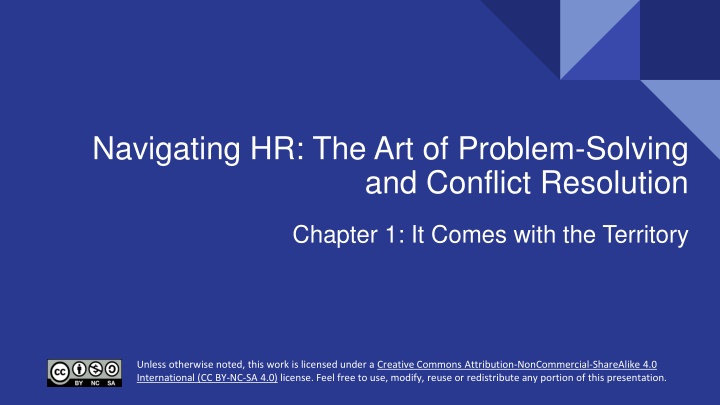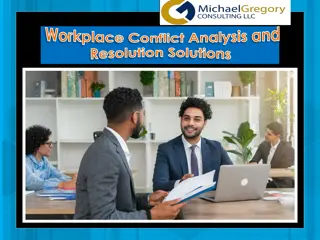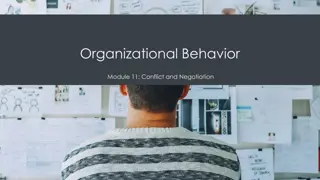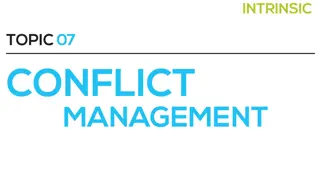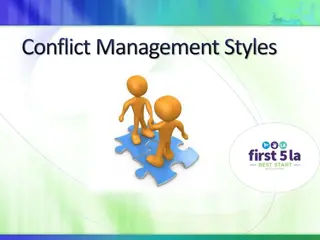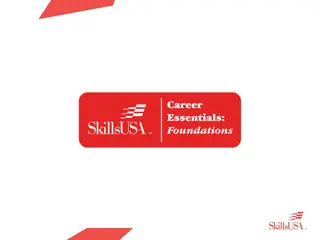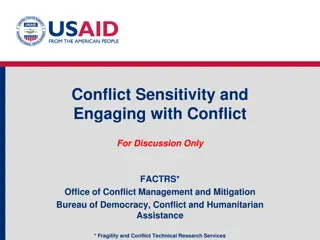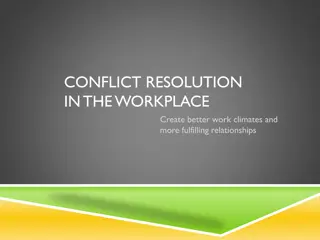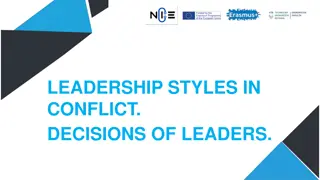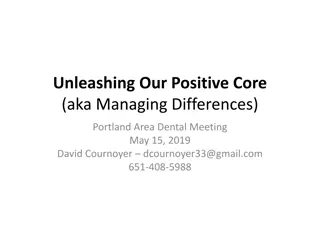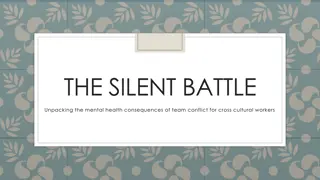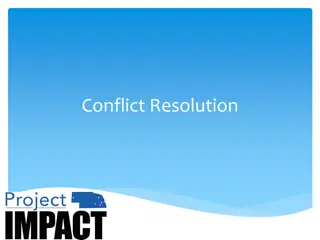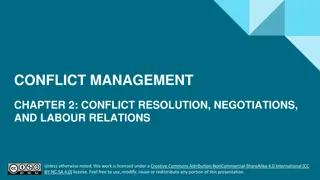Workplace Conflict in HR: Effective Resolution Strategies
Workplace conflict is a common challenge that HR professionals face. This chapter explores the factors contributing to conflict, the role of HR in problem-solving and conflict resolution, and the core competencies required for effective conflict management. By understanding workplace conflict and its underlying causes, HR professionals can proactively address issues and create a healthier work environment. Learn how to navigate workplace conflicts with insights on workplace and personal factors influencing conflict dynamics.
Download Presentation

Please find below an Image/Link to download the presentation.
The content on the website is provided AS IS for your information and personal use only. It may not be sold, licensed, or shared on other websites without obtaining consent from the author.If you encounter any issues during the download, it is possible that the publisher has removed the file from their server.
You are allowed to download the files provided on this website for personal or commercial use, subject to the condition that they are used lawfully. All files are the property of their respective owners.
The content on the website is provided AS IS for your information and personal use only. It may not be sold, licensed, or shared on other websites without obtaining consent from the author.
E N D
Presentation Transcript
Navigating HR: The Art of Problem-Solving and Conflict Resolution Chapter 1: It Comes with the Territory Creative Commons Attribution-NonCommercial-ShareAlike 4.0 International (CC BY-NC-SA 4.0) Creative Commons Attribution-NonCommercial-ShareAlike 4.0 International (CC BY-NC-SA 4.0) Unless otherwise noted, this work is licensed under a Creative Commons Attribution-NonCommercial-ShareAlike 4.0 International (CC BY-NC-SA 4.0) license. Feel free to use, modify, reuse or redistribute any portion of this presentation.
1.0 Learning Objectives In this chapter, we will: Explore the concept of workplace conflict from an HR perspective. Explain how an HR professional engages in problem-solving and conflict resolution. List common factors that influence workplace conflict.
1.1 Workplace Conflict Conflict is an active disagreement between people with opposing views or principles. It can occur between individuals, departments, or with external parties like customers and suppliers. Workplace conflict often disrupts productivity and can create an unhealthy environment. Understanding conflict is essential for Human Resources professionals to manage and resolve issues effectively. Photo by Sebastian Herrmann, Unsplash License
1.2 Human Resources Core Competencies The Problem Solver: You are known for brainstorming solutions and addressing concerns and challenges in a timely manner. The Conflict Resolution Advisor: You can identify disagreements between individuals and act as an advisor. The Coach: You provide people leaders with useful tips and approaches to address workplace conflict. The Communicator: You can communicate with others using verbal and non-verbal communication. Core Competencies by Sanaz Habibi CC BY-NC-SA
1.3 What is Behind Workplace Conflict? II HR professionals may encounter employees acting poorly or unusually, which can signal underlying issues. Exploring an employee s behaviour often reveals workplace or personal factors impacting them. Workplace factors are predictable across organizations, while personal factors are common but unique to each employee. When an individual is facing the pressure of taking care of their children and aging parents simultaneously, this is the sandwich generation.
1.3 What is Behind Workplace Conflict? I Workplace Factors Co-workers disagreements: about how to complete a project. Lack of resources: finances or time Job insecurity: concern a company will close or a job will be eliminated. Workplace conduct: harassment, teasing or bullying. Work overload: unrealistic amount of work. Unfair practices: treatment, favouritism, pay. Lack of career opportunities: promotions, training, mentoring.
1.3 What is Behind Workplace Conflict? Personal Factors Grief: loss of a partner, family member, or friend. Financial issues: bankruptcy. Marital issues: separation or divorce. Caretaking issues: childcare or parental care. Addiction: medication or alcoholism. Health issues: illness, injury, and mental health concerns. Work-life balance concerns: inability to enjoy downtime away from work. The Sandwich Generation by Sanaz Habibi, CC BY-NC-SA 4.0
1.4 Does Healthy Conflict Exist? Characteristics of a Healthy Conflict Those involved remain calm It can move a project forward There is a focus on the problem The situation remains respectful You hear professional language It allows for differing opinions Photo by Christina @ wocintechchat.com Unsplash License
1.4 Does Unhealthy Conflict Exist? Characteristics of an Unhealthy Conflict The situation feels uncomfortable There is a focus on the individual You hear bickering It may become loud You hear unprofessional language It involves blame Photo by Yan Krukau Pexels License
1.4 The Business Case for Resolving Unhealthy Conflict Business reasons to ensure unhealthy conflict is resolved: Increasing productivity Supporting healthy relationships Developing a workplace culture to be proud of Building inclusivity and belonging Encouraging employee engagement Making informed decisions Welcoming brainstorming Encouraging innovation and creativity Setting your organization apart from the competition
1.5 HR: a Conflict Resolution Coach As a Human Resources professional, there are two approaches to conflicts at work. One is to resolve the conflict yourself. The other approach is to coach people leaders to resolve workplace conflicts. Exercise: You work as the Human Resources Manager for a medium-sized manufacturing facility that employees 55 office staff. In addition, there are 80 employees on the day shift in the manufacturing facility, 70 on the afternoon shift, 50 on the night shift and 12 on the weekend shift. In total, there are 267 employees in this organization. 12 of these employees are people leaders. Discussion: Option 1. You can choose to coach 12 people leaders to address conflicts in their departments as they arise. Option 2. You can address any conflicts that arise among the 267 employees. Remember, none of these employees report to you. Which approach would you take and why?
1.6 Running Relay Ltd. Throughout this text, you will be introduced to workplace conflict scenarios at Running Relay Ltd. It is essential to introduce you to the staff at Running Relay. Please familiarize yourself with the employee names, job titles, and biographies as it will help you understand the role plays and scripts throughout this text. The Company: Runners Relay Ltd. Industry: Running Shoes Company Description: Runners Relay Ltd. was founded in 2015 by owner Frances Trembley (She/Her). Runners Relay is a small manufacturer of specialty running shoes, with a focus on environmentally friendly materials.
1.6 Meet the Staff at Running Relay Ltd: Office Staff Anna Suarez (She/Her) Human Resources Manager Anna has attained her Certified Human Resources Professional (CHRP) designation from the HRPA and hopes to apply for her CHRL designation in the next year. Andres Casso (He/Him) Office Manager Andres is the Office Manager at Runners Relay. Andres has been the Office Manager at Runners Relay for 5 years. Penn Livington (They/Them) Administrative Assistant Penn hopes to become the Office Manager at Runners Relay someday. Sunni Li (He/Him) IT Technician Sunni is a recent graduate excited to work full-time in his field of study.
1.6 Meet the Staff at Running Relay Ltd: Office Staff Continued Harmon Patel (He/Him) Safety and Environment Representative Harmon is passionate about safety and is excited to introduce new training programs to the team at Runners Relay. Roman Stanski (They/Them) Sales Associate Roman wants to grow his sales and take a course in public speaking to improve his sales skills. Chantal Russo (She/Her) Marketing Coordinator Chantal is taking a course on social media and hopes to apply what she learns at work.
1.6 Meet the Staff at Running Relay Ltd: Manufacturing Staff Helga Dietz (She/Her) Day Shift Supervisor Helga worked as a Production Associate for two years before being promoted to Supervisor. Svetlana Antonov (She/Her) Day Shift Production Associate Svetlana is new to Runners Relay and is job shadowing to learn the processes and equipment. Leonard Swartz (He/Him) Operations Manager Leonard has been hired to lead the manufacturing operation and introduce cost-saving opportunities. Sam Sellers (He/Him) Day Shift Production Associate Sam was working on the afternoon shift and recently transferred to the day shift at Runners Relay. Mikael Carlson (They/Them) Day Shift Production Associate Mikael is training to drive the new forklift at Runners Relay.
1.6 Meet the Staff at Running Relay Ltd: Manufacturing Staff Continued Aldona Jablonski (They/Them) Afternoon Production Associate Aldona is in a job rotation focused on learning additional jobs at Runners Relay. Alejandro Rodriguez (He/Him) Afternoon Shift Supervisor Alejandro is being mentored by Leonard Swartz. Jamal Greene (He/Him) Afternoon Production Associate Jamal hopes to move to the day shift based on his family s needs. Steven Thomas (He/Him) Afternoon Production Associate Steven is taking IT courses on the weekends and hopes to transition to an IT position at Runners Relay in the future.
1.7 Key Takeaways There will always be a certain amount of conflict within a workplace, the goal is to ensure it is healthy conflict. A positive workplace culture includes a workplace that is free of unhealthy conflict. Addressing unhealthy conflict in the workplace is part of a safe work environment. Human Resources professionals address workplace conflict by coaching people leaders to address conflict within their departments.
